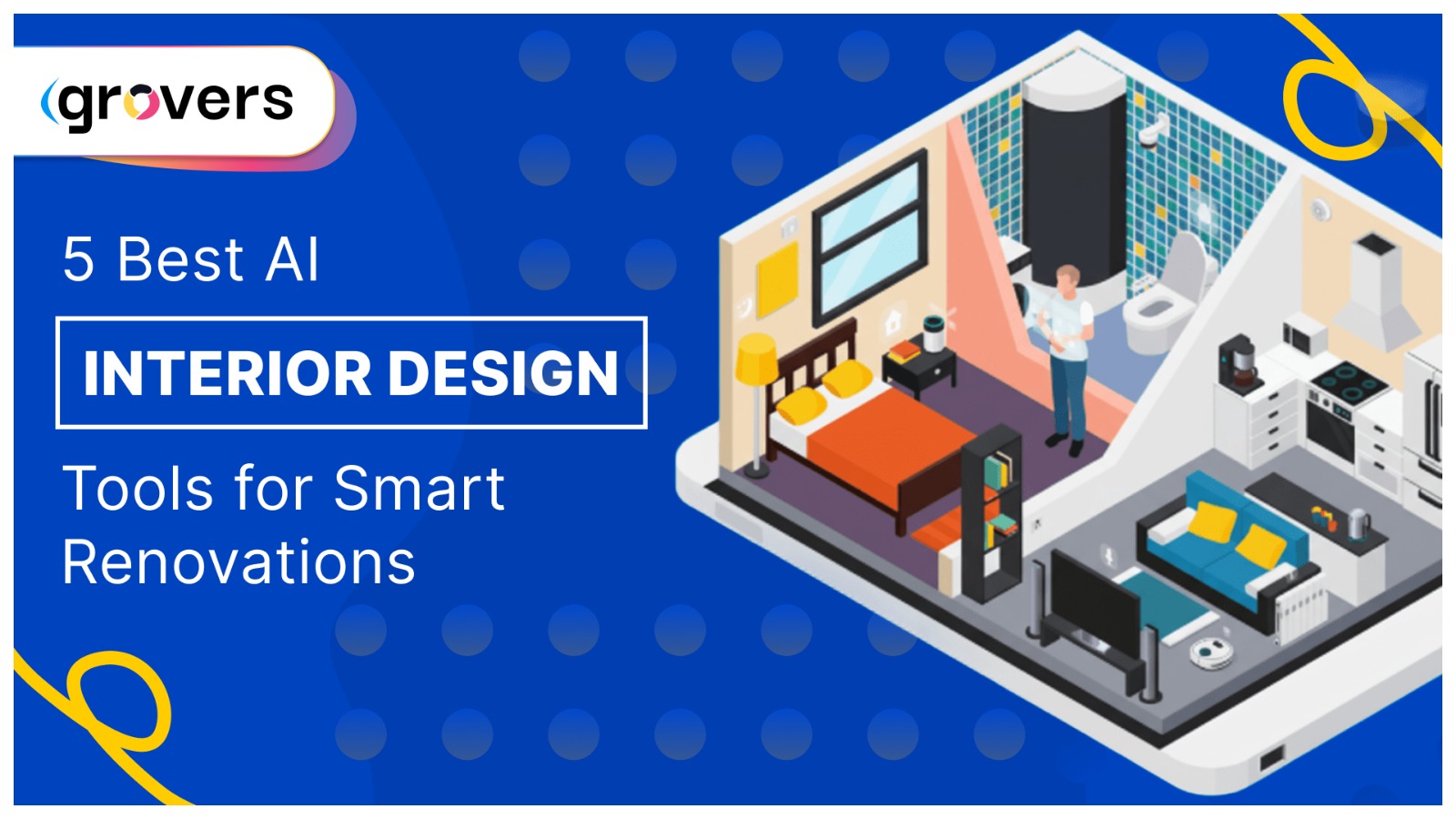Poor interior design choices can waste thousands of dollars on renovation projects. You buy furniture that doesn’t fit. You pick colors that clash and end up redoing everything. Managing your home renovation is tough, but finding the perfect tools to visualize your design? That’s next-level tricky. With so many AI interior design apps, some crammed with features you’ll never need, it’s easy to feel lost. So, how do you pick an AI interior design tool that actually works for your renovation instead of adding to the chaos? No worries, I have got your back.
I tested and compared the top AI interior design tools that homeowners and professional designers swear by. After all the heavy lifting, I narrowed it down to the 5 best tools just for you. But before we dive into the tools, let’s cover some basics for those new to AI interior design.
What is AI interior design?
Interior design is the process of using artificial intelligence to create, visualize, and plan interior spaces automatically.These tools analyze room photos, understand spatial relationships, and generate design concepts in seconds. AI interior design means transforming your existing spaces with new styles, furniture arrangements, and color schemes without physically moving anything.
For example, if you upload a photo of your empty living room, AI interior design software can show you how it would look with modern furniture, different paint colors, and new lighting fixtures. In the home renovation world, using AI for interior design comes with several perks like:
- Faster decision-making—See multiple design options in minutes instead of weeks
- Cost savings—Avoid expensive mistakes before buying furniture
- Realistic visualization—Know exactly what your space will look like before renovating
- Style exploration—Try dozens of design aesthetics without commitment
What are AI interior design tools?
AI interior design tools automate the visualization process. These platforms work by analyzing uploaded room photos using computer vision algorithms. They identify walls, furniture, lighting conditions, and spatial dimensions. Then they apply machine learning models trained on thousands of design styles to generate new concepts.
Now, AI interior design is used in many contexts but the 3 main types of users are:
- Homeowners planning renovations
- Interior designers creating client presentations
- Real estate agents needing virtual staging
Free AI interior design options provide basic functionality for homeowners testing ideas. AI interior design apps offer mobile convenience for on-the-go design work. Professional-grade AI interior design software delivers high-resolution renders for commercial projects. In this article, I’m zooming in on tools that work for both homeowners and professionals.
Why? Because after digging through hundreds of online conversations, it’s clear that most people struggle with finding the right balance between power and simplicity. But what criteria did I use to select the tools I’m talking about?
How to choose an AI interior design tool?
At first, I did what anyone would do, I Googled “best AI interior design tools.” Unsurprisingly, I found a ton of listicles claiming to showcase the “best tools” out there. But there’s a problem. Most of these articles don’t explain why the tools are the best.
They simply list features and pricing without digging into how these tools actually solve user pain points. What about their flaws and the real experience of using them? That’s often missing. Honestly, some of the content felt like it was churned out by GPT, with no depth or actual value. So, I set out to figure out what users really struggle with and what they need—and to find the best tools that solve it all.
What to look for in an AI interior design tool?
After hours of scouring Reddit posts, user reviews, and online conversations, I boiled it down to 6 key factors that matter most when picking an AI interior design tool:
- Render quality – Because blurry, unrealistic images are useless
- Ease of use – Nobody wants a tool that requires hours of tutorials
- Style variety – The more design options, the better
- Affordability – It’s gotta fit the budget
- Speed – Fast generation means faster decision-making
- Furniture shopping integration – Can you actually buy what you see?
To check render quality, I uploaded photos of real rooms and evaluated photorealism. I tested how well each tool handled lighting, shadows, furniture proportions, and spatial relationships. For ease of use testing, I follow the one-click-access rule. It means the key features of a tool must be one click away from the dashboard. I also checked how easy it is to set up and start generating designs. In addition, I also checked the processing speed and UI intuitiveness of each tool.
Style variety is super important for renovations. I tested each platform’s ability to generate modern, traditional, minimalist, rustic, and eclectic styles. The more options available, the higher the ranking. To verify affordability, I first checked if a tool offers a free AI interior design plan or at least free trial so users can try it before committing. Next, I checked the cost per month and what you actually get for your money. Speed matters when you’re making renovation decisions. I measured how long each tool takes to generate designs. Platforms that deliver results in under 60 seconds scored higher.
For more Art related inspirations please visit : AI Art Generators
Lastly, as I said, users don’t lie. I checked user reviews of each tool on G2, Capterra, and Reddit. So based on these factors, let’s see how my shortlisted tools performed.
Best AI interior design tools of 2025
Here are my top 5 contenders.
| Tool | Rating | Pricing/month | Accuracy | Ease of use | Best for |
| Paintit.ai | 9.4/10 | $24.99 | Excellent | Very easy | Overall use |
| REimagine Home | 8.8/10 | Pay-per-use | Very good | Easy | Homeowners |
| Planner 5D | 8.5/10 | $6.99 | Good | Moderate | Mobile users |
| Spacely AI | 9.2/10 | $30+ | Excellent | Advanced | Professionals |
| Interior AI | 8.6/10 | $39 | Very good | Easy | Style variety |
1. Paintit.ai
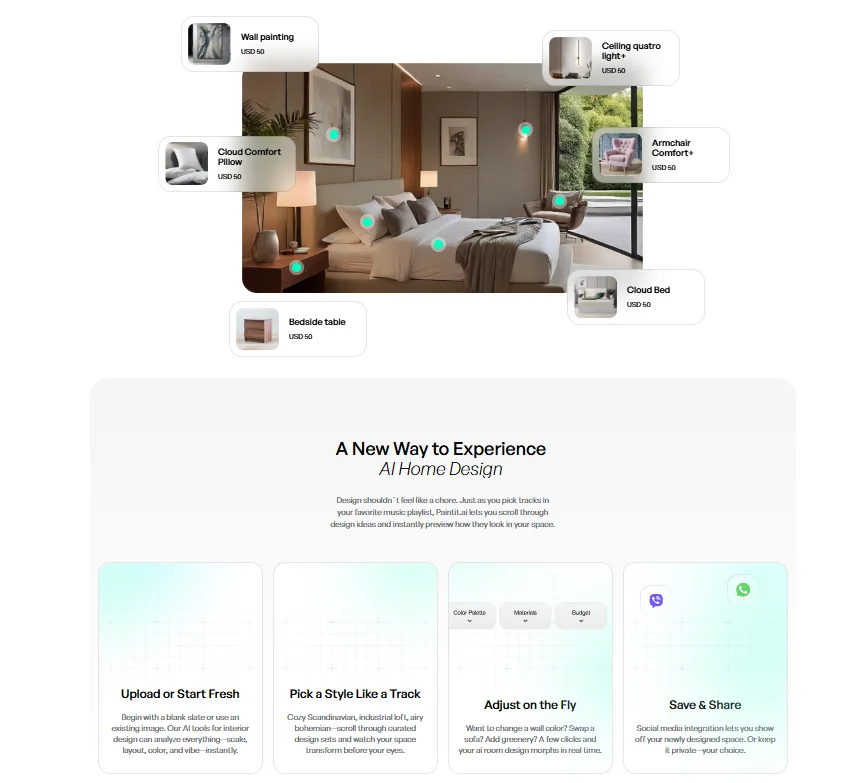
Paintit.ai stands out as the most innovative AI interior design platform in 2025, combining exceptional render quality with groundbreaking shoppable furniture integration.
Features:
- ChatGPT-style conversational interface for natural design discussions
- Shoppable furniture with links to IKEA and other retailers
- High-resolution renders suitable for professional presentations
- Multiple style generation from single photos
- Design history saved for future reference
- Commercial usage licensing included
Starting with render quality, Paintit.ai delivers the most photorealistic results in my testing. The AI successfully maintained room layout while adding design elements, and most remarkably, it preserved personal details like framed sports jerseys, demonstrating sophisticated image analysis capabilities.
I tested Paintit.ai with my living room photo, requesting a French Country transformation. The platform asked clarifying questions about my preferences before generating options. This conversational approach felt natural compared to other tools that just guess what you want. The standout feature is the furniture shopping integration. Below each generated design, you get real product links from retailers.
This solves the biggest problem with AI interior design, actually implementing what you see. The tool is super easy to use. You literally start designing in 2 clicks from the home screen. The chat-based interface might feel weird if you’re used to traditional design software. But within 5 minutes, I was generating designs faster than any other platform.
When I requested a vintage-style redesign of the same space, the tool delivered an equally compelling transformation with period-appropriate furniture and color schemes.
Pros:
- Most intuitive interface tested
- Exceptional render realism
- Revolutionary shoppable furniture feature
- Reasonable pricing with generous free tier
- Maintains chat history for easy reference
- Fast response times in conversations
Cons:
- Occasional window placement inaccuracies
- No mobile app currently available
- Limited offline functionality
From a render quality POV, Paintit.ai is unbeatable in the homeowner category. The conversational interface makes it feel like you’re working with a design consultant instead of software. The shoppable furniture integration is genuinely innovative. But the biggest win for me is how it handles iteration. You can refine designs through conversation instead of starting over. If you’re renovating your home and want realistic visualizations with actual shopping options, Paintit.ai is worth every penny.
2. REimagine Home
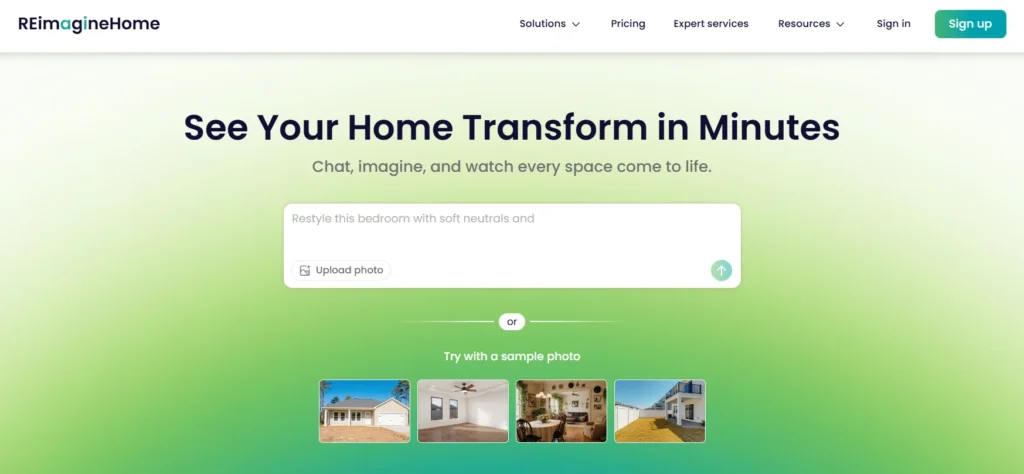
REimagine Home strikes the perfect balance between sophistication and simplicity, making it ideal for homeowners without design experience.
Features:
- Photo upload with instant redesign
- Exterior and outdoor space design capabilities
- Virtual staging for empty rooms
- Pay-per-download pricing model
- Masking controls for selective redesign
- “Surprise Me” mode for unexpected style suggestions
Unlike other tools with monthly subscriptions, REimagine Home uses a pay-per-download model. You generate unlimited designs but only pay when you download the ones you want to keep. This approach saves money for homeowners exploring options. The platform’s unique pay-per-download model and outdoor space capabilities set it apart from competitors.
In my testing, I uploaded a photo of my bedroom and requested Mid-Century Modern styling. The results impressed me. The tool preserved the room’s layout while adding period-appropriate furniture, warm wood tones, and vintage lighting fixtures. REimagine Home excels at outdoor spaces. Most AI interior design apps only handle indoor rooms. This platform can redesign patios, gardens, and exterior facades. That’s huge for complete home renovations.
The interface prioritizes simplicity without sacrificing functionality. You upload a photo, select a style from curated options, and generate variations before downloading. The workflow feels natural for non-designers. One feature I loved is the “Surprise Me” mode. The AI suggests unexpected style combinations you might not consider. This helped me discover design directions I wouldn’t have explored otherwise.
Pros:
- Pay only for designs you want to keep
- Outdoor and exterior design capability
- Clean, beginner-friendly interface
- Empty room virtual staging
- Fast generation times (1-2 minutes)
- No credit card required for free renders
Cons:
- Limited style customization options
- No floor plan creation tools
- Fewer advanced features than professional platforms
- Cannot edit specific elements after generation
If you’re looking for a free AI interior design experience with the option to pay only for keepers, REimagine Home is perfect. The pay-per-download model beats subscriptions for homeowners doing one-time renovations. You’re not locked into monthly fees.
I’d prefer Paintit.ai for conversational design refinement. But if budget flexibility matters more, REimagine Home wins. The outdoor space feature is genuinely unique. No other tool in this list handles exterior design as well. For a typical room renovation, you might generate 20-30 designs to explore options, then download 3-5 favorites. That costs $10-20 total versus $25-40 in monthly subscriptions elsewhere.
3. Planner 5D
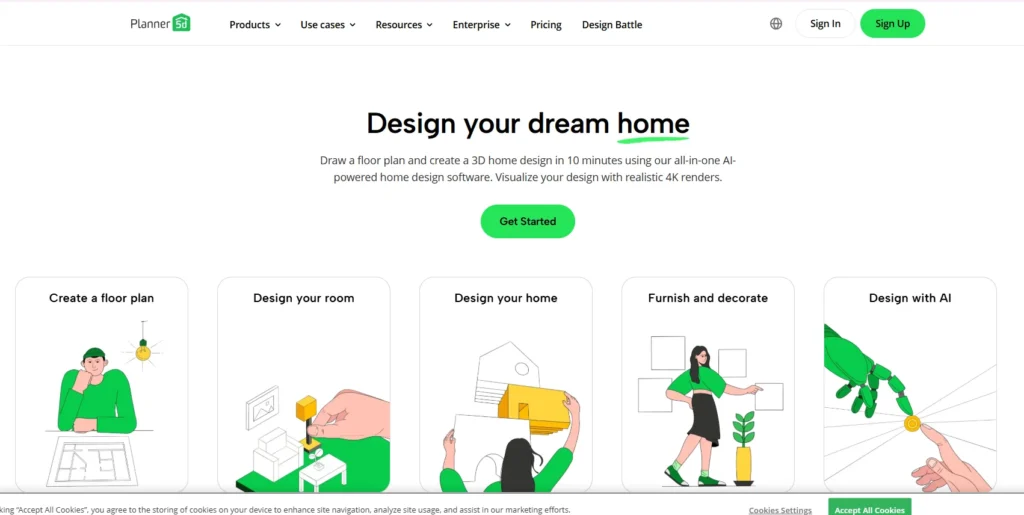
Planner5D offers the most comprehensive mobile experience, allowing users to create floor plans, generate AI designs, and even try AR visualization on their smartphones.
Features:
- Floor plan creation with precise measurements
- 2D and 3D visualization modes
- Room scanning with phone camera
- AR furniture placement
- Massive furniture and decor library (thousands of items)
- Cross-platform sync between desktop and mobile
- Virtual reality walkthrough mode
Planner 5D combines traditional floor planning with modern AI for interior design.
This hybrid approach appeals to users who want both precision and creativity. The AI interior design app shines on mobile devices. The mobile app includes room scanning capabilities, AR try-on features, and full design generation tools, making it truly portable. In my testing, I used the room scanning feature to create a 3D model of my home office. The app accurately captured dimensions using my phone camera. Then I applied AI-generated designs to see different styles in my actual space.
The AR visualization lets you place virtual furniture in your real room through your phone screen. This feature helps verify that furniture sizes work before purchasing. It’s the closest thing to trying before buying. The furniture library includes thousands of items from real manufacturers. You can browse catalogs, place items manually, or let AI suggest complete room designs. The tool offers moderate complexity. Floor plan creation requires more learning than photo-based AI tools.
But once you understand the interface, the workflow becomes efficient. Planner 5D works great for users who want detailed planning alongside quick AI visualization.
Pros:
- Best mobile experience tested
- AR furniture visualization
- Detailed floor plan tools with measurements
- Huge furniture catalog
- Room scanning technology
- VR walkthrough capabilities
Cons:
- Steeper learning curve than photo-only tools
- AI generation quality below Paintit.ai
- Credit system for AI renders can get expensive
- Interface feels cluttered with many options
Planner 5D works best for users who want complete design control from floor plans to final visualization. The mobile experience genuinely impressed me. Most AI interior design apps feel like stripped-down versions of desktop software. Planner 5D’s mobile app offers full functionality including AR features. But I found the AI generation quality below Paintit.ai and REimagine Home. The renders look less photorealistic and sometimes furniture proportions feel off.
If you need floor plans and measurements alongside AI visualization, Planner 5D is worth it. If you only want quick room redesigns, simpler tools work better. The AR feature alone justifies trying the free version. Being able to see virtual furniture in your actual space through your phone is incredibly helpful for making purchase decisions.
4. Spacely AI
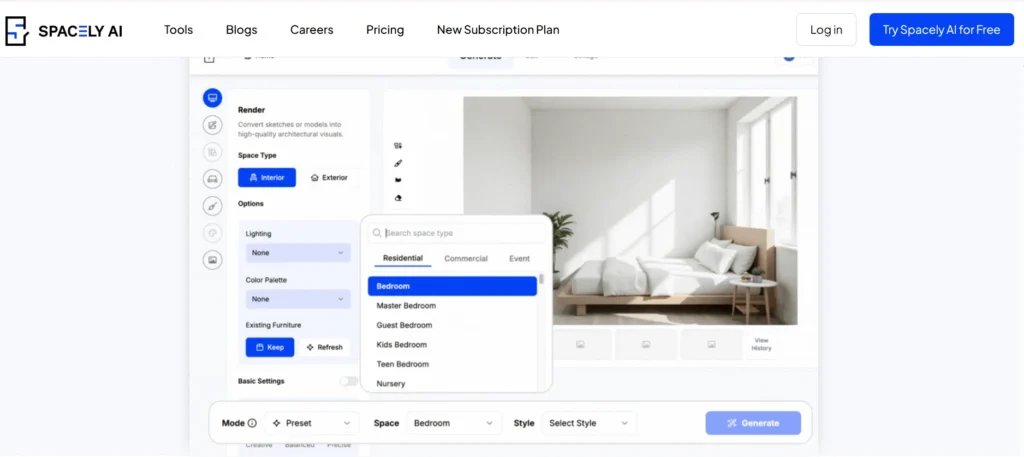
Spacely AI delivers the most advanced feature set for professional interior designers, offering unprecedented control over generated designs.
Features:
- Post-generation editing of specific elements
- Style upload using reference images
- High-resolution exports for client presentations
- Advanced lighting and material controls
- Collaborative tools for design teams
- Custom prompt capabilities with detailed specifications
- Batch processing for multiple rooms
Spacely AI targets professional designers specifically. The platform assumes design knowledge and provides advanced controls that would overwhelm casual users.
The standout feature is Spacely’s post-generation editing capabilities. Unlike other tools that generate static images, Spacely allows designers to modify specific elements, adjust furniture placement, and re-render only changed sections. In my testing, I generated a Ryokan-style Japanese design. The initial render looked good but needed adjustments. Instead of regenerating entirely, I used Spacely’s editing tools to modify individual furniture pieces, adjust lighting, and change materials. This iterative approach saves massive time compared to platforms that force complete regeneration.
The Ryokan-style transformation demonstrated Spacely’s ability to handle complex cultural aesthetics with authenticity. Traditional Japanese design elements appeared correctly, maintaining spatial logic and proportion. The render quality matches professional visualization software. Lighting, shadows, and material textures look photorealistic. Spacely excels at handling complex design styles that confuse other AI tools.
The platform offers style upload capability. You can provide reference images defining custom aesthetics. This helps designers match client mood boards or implement specific brand guidelines. The tool requires design knowledge to use effectively. Professional designers will appreciate the granular control. Homeowners might find the interface overwhelming.
Pros:
- Highest render quality tested
- Post-generation editing capability
- Advanced customization controls
- Professional export options (high resolution)
- Team collaboration features
- Excellent customer support for professionals
Cons:
- Steep learning curve for beginners
- More expensive than consumer-focused tools
- Overwhelming interface for casual users
- Requires design knowledge to maximize value
If you’re a professional designer needing photorealistic renders with granular control, Spacely AI is the best option. The post-generation editing feature alone justifies the higher price for professionals. It eliminates countless hours of regeneration cycles. But homeowners should skip this unless they have design experience. The interface assumes professional knowledge. I’d prefer Paintit.ai for ease of use. But if I needed perfect renders for paying clients, Spacely AI wins.
The ability to modify specific elements without starting over makes iteration so much faster. For professionals billing by the hour, this efficiency pays for itself quickly.
5. Interior AI
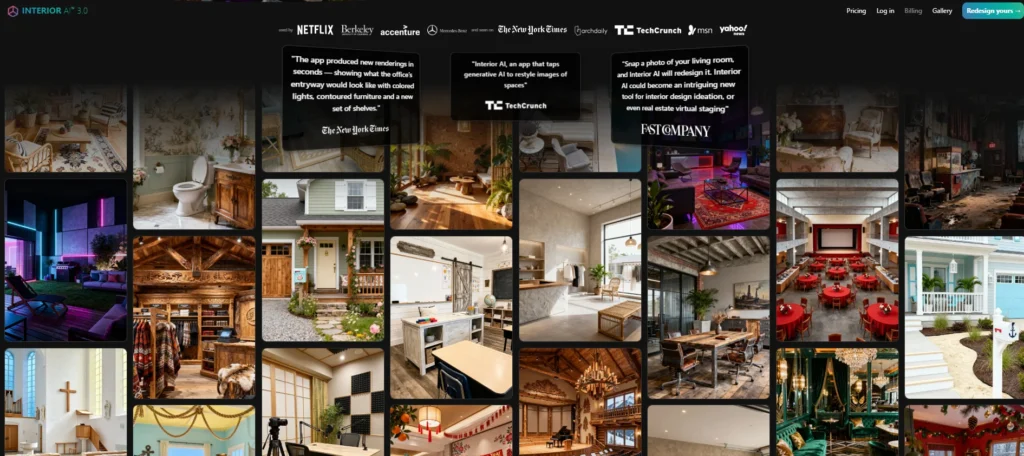
Interior AI leads the market in style variety, offering over 40 distinct design aesthetics from traditional to avant-garde.
Features
- 40+ design style options covering all major movements
- Virtual staging mode for real estate
- Sketch-to-image transformation
- Fast processing under 60 seconds
- Multiple variations per generation
- Commercial usage licensing
- Batch upload for multiple rooms
Interior AI solves one specific problem better than competitors: style variety. If you’re exploring different design directions and want maximum options, this platform delivers.
The tool offers styles ranging from Art Deco to Zen minimalism. From Art Deco to Zen minimalism, Interior AI demonstrates remarkable versatility across design movements, with each style feeling authentic rather than generic. In my testing, I uploaded the same bedroom photo and generated designs in 15 different styles. The variety impressed me. Each style felt authentic instead of generic variations of the same concept.
Interior AI excels at contemporary and transitional styles according to my testing. Traditional and cultural styles work well too, though not as authentically as Spacely AI handles complex cultural aesthetics. The virtual staging mode targets real estate professionals. You can transform empty rooms into furnished spaces for property listings. This feature works faster than manually staging rooms for photography. The sketch-to-image capability lets you draw rough floor plans or design concepts. The AI transforms sketches into photorealistic renders.
This helps during early brainstorming when you have ideas but no photos. The interface offers moderate simplicity. You upload photos, select styles from the extensive library, and generate designs. The workflow feels straightforward. Processing speed impressed me. Average generation time under 60 seconds makes exploring multiple styles feasible in single sessions.
Pros:
- Largest style library tested (40+ options)
- Fast generation times
- Virtual staging for real estate
- Sketch-to-image capability
- Good render quality across most styles
- Batch processing saves time
Cons:
- No free tier for testing
- Slightly expensive for casual use
- Some styles work better than others
- Limited post-generation editing
- Requires subscription commitment to test
If style exploration matters most for your renovation, Interior AI is worth considering. The 40+ style options help you discover design directions you might not have considered. The fast generation times make exploring feasible. But would prefer Paintit.ai for overall usability and furniture shopping integration. Interior AI focuses on visualization without implementation help. The lack of free tier bothers me. You commit $39 before testing whether the styles match your preferences.
For real estate virtual staging, this tool works great. For homeowner renovations, tools with shopping integration add more value. The speed advantage really shines when you need to generate 50+ variations across different styles. You can complete that in under an hour versus half a day with slower tools.
Comparison table: AI interior design tools
| Tool | Rating | Monthly Price | Free Tier | Render Quality | Speed | Best Feature |
| Paintit.ai | 9.4/10 | $24.99 | Yes | Excellent | 2-5 min | Shoppable furniture |
| REimagine Home | 8.8/10 | Pay-per-use | 5 free renders | Very good | 1-2 min | Outdoor spaces |
| Planner 5D | 8.5/10 | $6.99 | Yes | Good | Varies | AR visualization |
| Spacely AI | 9.2/10 | $30+ | 3-day trial | Excellent | 3-5 min | Post-gen editing |
| Interior AI | 8.6/10 | $39 | No | Very good | Under 60 sec | 40+ styles |
Free AI interior design options worth exploring
Several platforms offer substantial free functionality for budget-conscious homeowners. AI Room Planner provides completely free AI interior design with unlimited generations. AI Room Planner offers the most generous free tier tested, with unlimited generations and no watermarks on downloaded images. The render quality doesn’t match paid tools, but it’s perfect for initial concept exploration. RoomGPT offers a free tier with limited generations. RoomGPT prioritizes speed and simplicity, delivering design transformations in under 30 seconds for users who need quick ideation.
The ultra-fast processing makes it valuable for rapid brainstorming sessions. Most premium platforms provide generous trial periods. You can complete small projects entirely within trial limitations. Strategic timing maximizes free usage potential. Start trials when you’re ready to generate designs intensively. Free tiers help users understand AI design capabilities before committing financially. Learning curve investment reduces with zero-cost experimentation.
Skill development accelerates through hands-on practice.
Choosing the right AI interior design tool
Your experience level significantly influences platform selection. Beginners benefit from Paintit.ai’s conversational interface or REimagine Home’s simplicity. Advanced users prefer Spacely AI’s customization options and professional-grade outputs.
Project scope considerations
- Single room renovations suit simple photo-based AI interior design apps perfectly.
- Whole-house renovations require comprehensive platforms like Planner 5D with floor planning capabilities.
- Commercial spaces need professional-grade rendering like Spacely AI provides for client presentations.
Budget planning
- Free tools work well for inspiration and initial concepts. Paid platforms become necessary for high-resolution outputs and detailed project development.
- Pay-per-use pricing like REimagine Home suits one-time renovations better than monthly subscriptions.
- Subscription models suit ongoing projects or professional designers working with multiple clients.
Technical requirements
- Mobile-only users need apps optimized for smartphone interfaces like Planner 5D.
- Desktop users can access more powerful processing capabilities through web-based platforms.
- Internet connectivity requirements vary significantly between platforms. Some tools require constant connection while others allow offline work.
How to get better results from AI interior design tools
Photo quality dramatically impacts AI analysis accuracy. Well-lit photos with minimal shadows produce optimal results. Shoot straight-on instead of angled for better spatial understanding. Multiple angles help algorithms understand room dimensions better. Include photos showing adjacent spaces for context.
Writing effective prompts
- Instead of vague requests like “modern design,” try “Scandinavian minimalist with warm wood accents and neutral textiles.”
- Include functional requirements like “pet-friendly materials” or “home office space for video calls.”
- Specify lighting preferences such as “warm ambient lighting” or “bright task lighting for reading.”
- Mention color preferences using descriptive terms like “sage green accent wall” or “warm earth tone palette.”
Iteration approach
Generate multiple variations before making decisions. AI interior design tools excel at rapid iteration cycles. Compare options side-by-side for objective evaluation instead of judging designs individually.
- Don’t settle for first results. Most platforms improve with additional generations as the AI understands your preferences.
- Save your favorites in a collection for final comparison. Looking at 5-10 top options together reveals subtle differences.
Reality checking
- Verify measurements and proportions manually when possible. AI suggestions may not account for structural limitations.
- Consult professionals for significant renovation decisions involving plumbing, electrical, or load-bearing walls.
- Remember that AI-generated furniture often doesn’t exist exactly as shown. You’ll need to find similar items from actual retailers.
- Check if suggested furniture fits through doorways and up staircases. AI doesn’t understand access limitations.
Why didn’t I include other popular tools?
Several well-known AI interior design platforms didn’t make my final list. Let me explain why.
- Homestyler offers comprehensive features but the interface feels cluttered. The learning curve is too steep for casual users while professionals prefer specialized tools.
- DecorMatters gamifies design too much. The community features are fun but the core AI functionality lacks the quality needed for serious renovations.
- Visualize AI serves niche architectural needs beyond typical interior design. It’s excellent for product design but overkill for room renovations.
I focused on tools that balance power with usability. Every tool in my list can be used effectively within 30 minutes of first access.
FAQs
Can AI interior design replace professional designers?
AI tools help with visualization and concept generation. But they cannot replace professional expertise for spatial planning, building codes, structural considerations, and project management. The best approach combines AI interior design software efficiency with professional consultation for implementation.
How accurate are AI-generated room designs?
Accuracy depends on photo quality and room complexity. AI tools work best with accurate room photos, but cannot guarantee precise measurements. Simple rectangular rooms achieve high accuracy.
Do AI interior design tools work on mobile?
Several platforms offer mobile functionality. Planner 5D provides the most comprehensive mobile experience with room scanning and AR visualization. Most tools work through mobile browsers though desktop versions offer better performance.
Can I buy the furniture shown in AI designs?
This varies by platform. Paintit.ai provides direct links to real products from retailers like IKEA. Other tools show conceptual furniture requiring manual sourcing. Most AI-generated furniture doesn’t exist exactly as shown, so expect to find similar alternatives.
Are free AI interior design tools worth using?
Free options provide basic functionality for homeowners testing ideas. AI Room Planner offers unlimited free generations suitable for initial concept exploration. Free tiers help you understand AI capabilities before committing to paid plans.
Conclusion
That’s a wrap on the best AI interior design tools. All the platforms I’ve shared offer free tiers or trials so you can test them yourself and choose the best one for your renovation. The interior design industry transformed dramatically in 2025. Traditional design processes taking weeks now happen in minutes through artificial intelligence.
After testing these platforms extensively, I learned that the best tool depends on your specific needs. Homeowners benefit most from Paintit.ai’s combination of quality, ease of use, and shopping integration. The key is understanding that AI interior design serves as a collaboration tool, not a replacement for human creativity or professional expertise. These platforms show you possibilities, help visualize changes, and even suggest where to buy furniture.
But the heart of your home, the way it feels when you walk in, the memories you create in those spaces, remains entirely, beautifully human. So go ahead. Upload that photo of your living room. Try a few different styles. See what sparks joy, what feels like home, what makes you think “yes, this is it.” Your perfect space is waiting to be discovered, and now you have the tools to find it.
